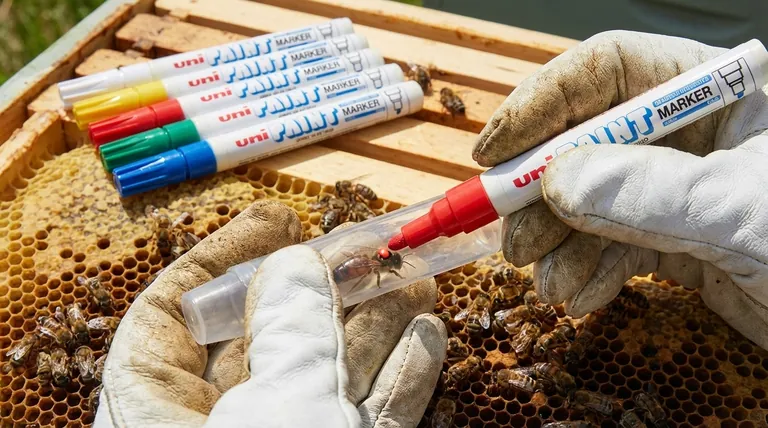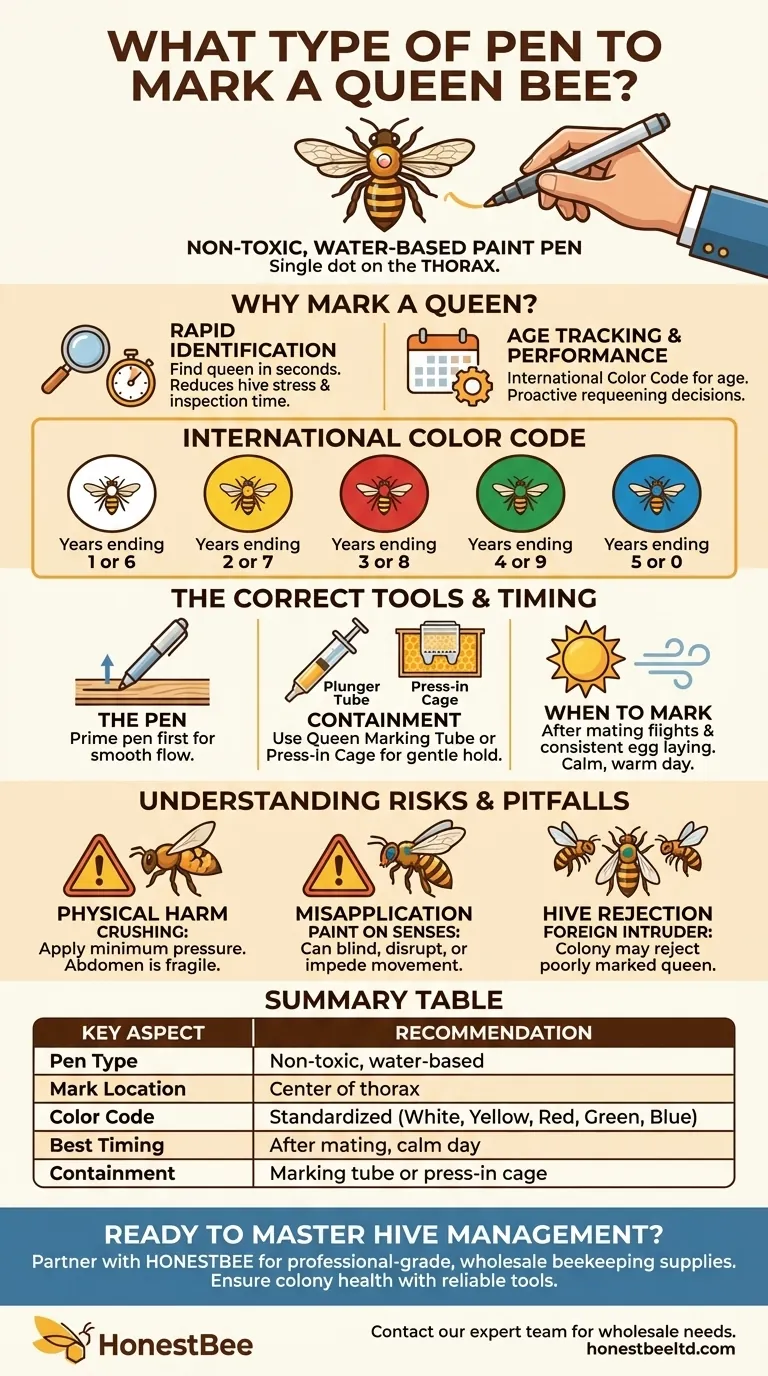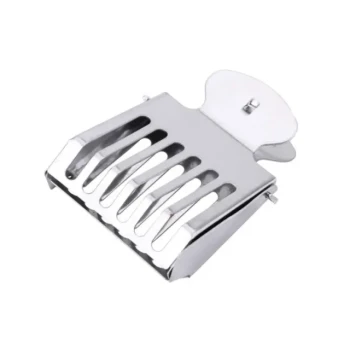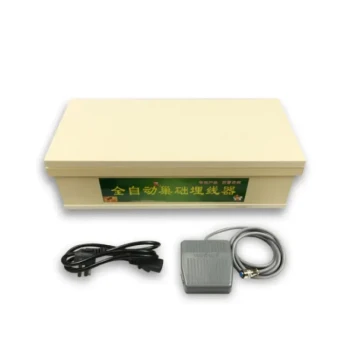To mark a queen bee, you must use a non-toxic, water-based paint pen specifically designed for this purpose. The mark is a single, small dot applied directly to the center of her thorax—the hard-shelled middle section of her body between her wings. This ensures the paint does not interfere with her movement, senses, or acceptance by the colony.
Marking a queen is more than just a task; it's a fundamental practice in hive management. The choice of pen is simple, but the true challenge lies in the technique, timing, and understanding of bee behavior to ensure the queen's safety and the hive's stability.

Why Mark a Queen Bee?
Marking your queen provides two significant advantages for hive management. It transforms a difficult task—finding one specific bee among tens of thousands—into a simple, visual check.
Rapid Identification
A marked queen can be located in seconds rather than minutes. This dramatically reduces the time frames are out of the hive, minimizing stress on the colony during inspections.
Quick identification is critical for confirming if a hive is "queenright" (has a healthy, laying queen) or if you need to troubleshoot issues like a sudden drop in egg production.
Age Tracking and Performance
Beekeepers use an international color code to mark queens based on the year they were born or introduced. This system allows you to know a queen's age at a glance.
The standardized color rotation is:
- Years ending in 1 or 6: White
- Years ending in 2 or 7: Yellow
- Years ending in 3 or 8: Red
- Years ending in 4 or 9: Green
- Years ending in 5 or 0: Blue
Tracking age helps you make proactive decisions about requeening before a queen's productivity naturally declines, preventing a costly dip in colony population and honey production.
The Correct Tools and Timing
Success depends on having the right equipment and choosing the right moment. Rushing this process is the most common cause of failure.
The Marking Pen
Your primary tool is the non-toxic, water-based paint pen. Before you even approach the hive, prime the pen on a separate surface (like a piece of wood or your glove) to ensure the paint flows smoothly and evenly. A sputtering pen can create a mess and harm the queen.
Secure Containment Methods
You must immobilize the queen gently to apply the mark. Holding her with your bare fingers requires significant skill and is not recommended for beginners.
A queen marking tube is a common tool. It features a plunger with a soft foam tip that gently presses the queen against a plastic screen, giving you clear access to her thorax.
A press-in cage is another option. You locate the queen on a frame and press the cage over her into the comb, trapping her securely against the foundation for marking.
When to Mark Your Queen
Timing is crucial. The ideal time to mark a queen is after she has completed her mating flights and has started laying eggs consistently.
Wait for a calm, warm day with minimal wind. This ensures the bees are in a better mood and the paint can dry quickly without running. If you introduce a new queen, give the colony a week or two to accept her before attempting to mark her.
Understanding the Risks and Pitfalls
Marking a queen is a delicate procedure with real consequences if done incorrectly. Understanding the risks is the first step to avoiding them.
Physical Harm to the Queen
The greatest risk is accidentally crushing the queen. Whether using your fingers or a marking tube, apply only the absolute minimum pressure needed to hold her still. Her abdomen is particularly fragile.
Misapplication of Paint
The mark must be only on the hard, bald spot on her thorax. Getting paint on her eyes, antennae, wing joints, or mouthparts can blind her, disrupt her senses, or impede her movement.
Any misplaced paint can also be interpreted by the worker bees as a defect, which can lead to the hive rejecting and killing their own queen.
Hive Rejection
Even with a perfect mark, there is a small risk the colony will perceive the newly painted queen as a foreign intruder. This is why it's vital to release her gently back onto the frame she came from and minimize hive disturbance.
Making the Right Choice for Your Goal
Once you understand the principles, you can apply them to your specific situation. Your approach should be guided by your experience level and primary objective.
- If you are a new beekeeper: Your primary goal is the queen's safety. Consider buying queens that are already marked, or practice handling and containing drones (male bees) before you attempt to mark your first queen.
- If your primary focus is rapid inspection: A bright, clean mark on the thorax is your goal. Ensure your pen is well-primed to create a solid dot that is instantly visible when you open the hive.
- If your primary focus is tracking genetics and age: Adhering strictly to the international color code is non-negotiable. This discipline will pay dividends in long-term hive management and requeening decisions.
Mastering this skill is a sign of a beekeeper who is deliberate, careful, and deeply invested in the long-term health of their colonies.
Summary Table:
| Key Aspect | Recommendation |
|---|---|
| Pen Type | Non-toxic, water-based paint pen |
| Mark Location | Center of the thorax |
| International Color Code | White (1/6), Yellow (2/7), Red (3/8), Green (4/9), Blue (5/0) |
| Best Timing | After mating flights, on a calm, warm day |
| Containment Tool | Queen marking tube or press-in cage |
Ready to master hive management with professional-grade tools?
At HONESTBEE, we supply commercial apiaries and beekeeping equipment distributors with the highest-quality, wholesale-focused supplies. Our reliable marking pens and equipment help you perform essential tasks safely and efficiently, protecting your valuable queens and ensuring colony health.
Contact our expert team today to discuss your wholesale needs and elevate your beekeeping operations.
Visual Guide

Related Products
- Queen Bee Marking Pen UNI Medium Point for Queen and Bee Marking
- Queen Bee Marking Pen POSCA Queen Marking Pens for Beekeeping Bee Markers
- Professional Engraved Round Hive Number Tags for Beekeeping
- Wooden Bee Brush with Triple Row Artificial Fiber for Beekeeping
- Wooden Bee Brush with Double-Row Horsehair Bristles
People Also Ask
- What are the benefits of marking queen bees? Boost Hive Health & Management Efficiency
- What are the characteristics of Posca pens for marking queens? A Safe, Durable Solution for Hive Management
- Why is marking a Queen bee important for beekeepers? Elevate Your Apiary Management
- What type of markers are commonly used for marking Queen bees? Choose the Safe, Non-Toxic Standard
- What are the color codes in the queen-marking system? Master Hive Management with the 5-Year Cycle



















